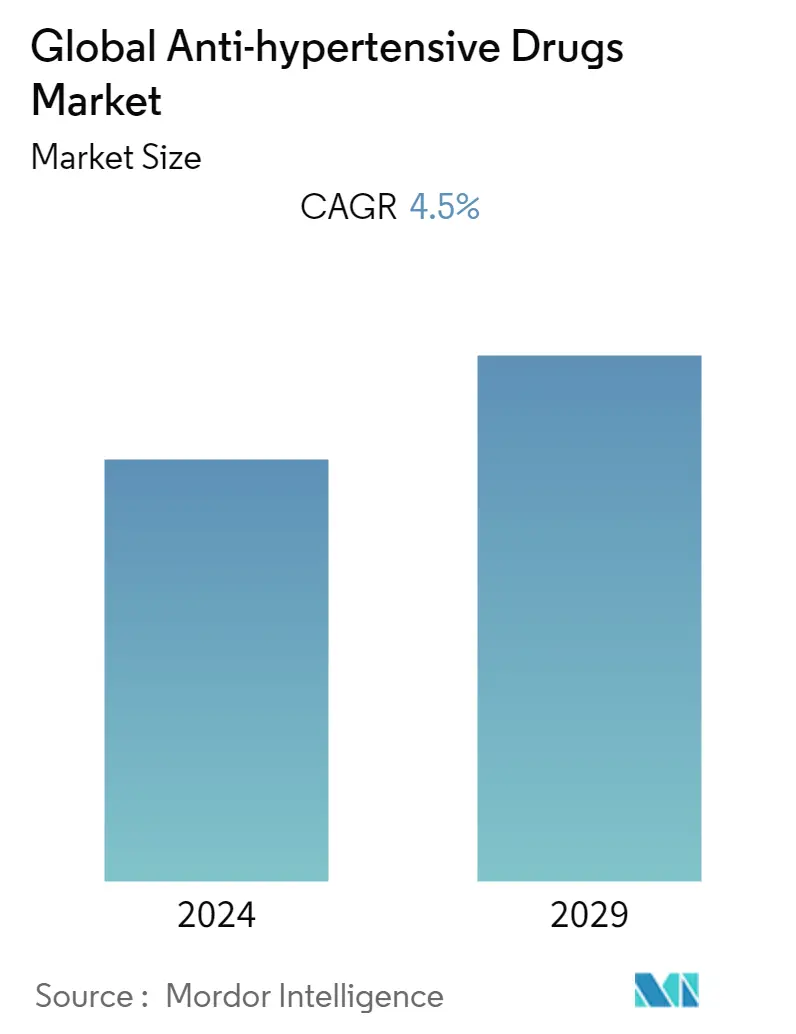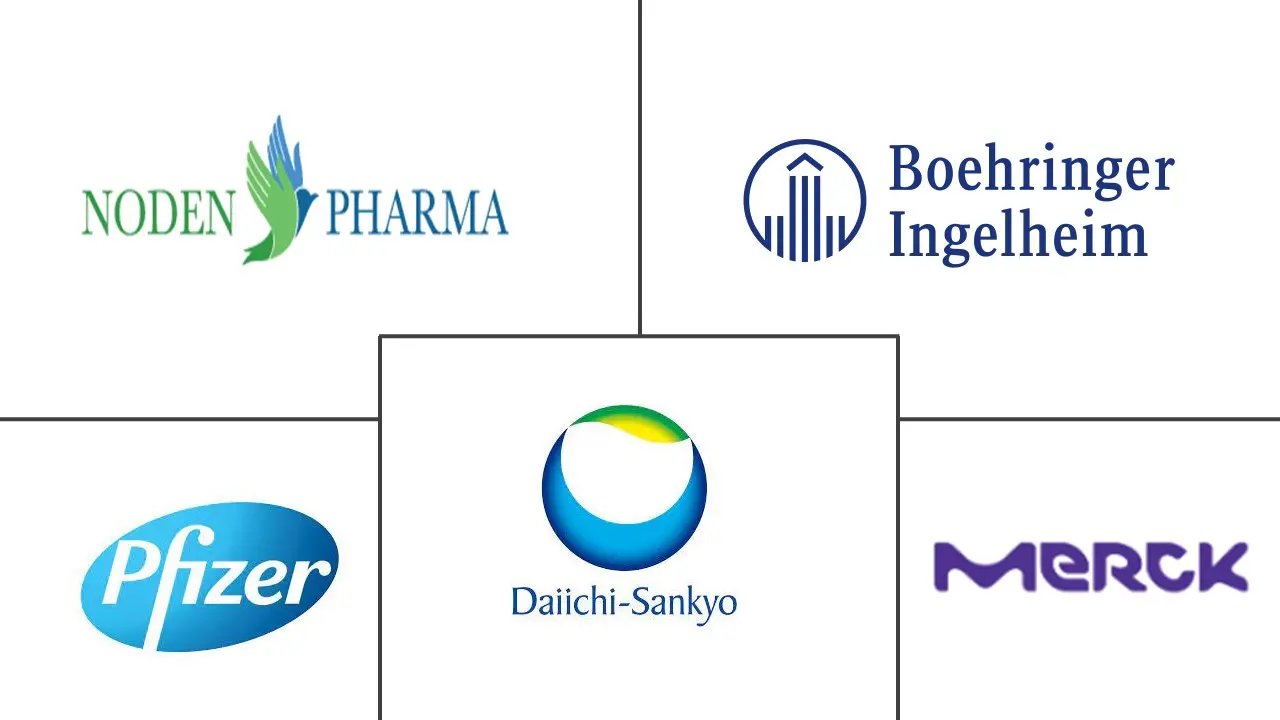Market Size of Global Anti-hypertensive Drugs Industry

| Study Period | 2019 - 2029 |
| Base Year For Estimation | 2023 |
| CAGR | 4.50 % |
| Fastest Growing Market | Asia-Pacific |
| Largest Market | North America |
| Market Concentration | Low |
Major Players
*Disclaimer: Major Players sorted in no particular order |
Anti-hypertensive Drugs Market Analysis
The anti-hypertensive drugs market is expected to register a CAGR of 4.5% during the forecast period (2021 to 2026).
The COVID-19 outbreak had a significant impact on people with hypertension. Also, due to lockdown and other restrictions imposed by governements to curb the spread of the infection from the Covid-19 virus, the lifestyle of patients with hypertension was severely impacted. As per the study titled "COVID-19 in Patients with Hypertension" published in Advances in Experimental Medicine and Biology in July 2021, hypertension individuals who have COVID-19 have an increased risk of mortality that is at least two times higher; nevertheless, renin-angiotensin-aldosterone system (RAAS) inhibitors that have been offer protection for this subgroup of patients which in turn expected to boost the growth of the anti-hypertensive drugs market.
One of the leading factors responsible for the growth of the anti-hypertensive drugs market is the rising prevalence of hypertension among people around the world. The major known causes of hypertension are kidney diseases, diabetes, obstructive sleep apnea, and other cardiovascular diseases due to which the prevalence of hypertension has been observed a significant rise over the past few years. Also, some drugs can induce hypertension in patients with other diseases or disorders which in turn is expected to promote the growth of the studied market. As per the updated May 2021 data from the World Health Organization, about 1.13 billion people around the world have hypertension, of which two-third are living in low- and middle-income countries. In the report published in June 2020 titled 'A Global View on Prevalence of Hypertension and Human Development Index' to determine the relationship between the prevalence of hypertension and human development index (HDI) concluded that the prevalence of hypertension ranged from 35% to 41% among 182 countries around the world. Thus, the rising prevalence of hypertension is expected to drive the growth of the anti-hypertensive drugs market.
Certain other factors that will boost the growth of the anti-hypertensive drugs market include growing initiatives by private and government organizations and rising awareness about hypertension around the around. For instance, in May 2022, Glenmark Pharmaceuticals conclude the hypertension awareness symbol backed by the Association of Physicians of India (API) and Hypertension Society of India (HIS). Additionally, in May 2022, Namya Smile Foundation (NSF) organized an awareness campaign in India related to hypertension among people. The organization conducted a camp and checked the blood pressure and made them aware of various aspects of high blood pressure.
Whereas factors such as expiration of patent of multiple major drugs along with side effects associated with the hypertension treatment and rise in the availability of other non-pharmacological based therapy will restrict the growth of the anti-hypertensive drugs market. For Instance, In December 2021, AbbVie, the parent company of Allergan, lost the patent of its anti-hypertensive drug, Bystolic (Nebivolol). Nebivolol is a beta blocker used to treat high blood pressure and heart failure. Additionally, market participants frequently introduce new products and use a variety of growth tactics in their particular segments, which is likely to spur market expansion. For Instance, in December 2021, Dr Reddy's Laboratories has launched Valsartan tablets, used for treatment of high blood pressure and heart failure, in the United States market. The Valsartan tablet is the generic therapeutic equivalent of Diovan, approved by the United States Food and Drug Administration (USFDA). Similarly, in November 2021, Otsuka Pharmaceutical Co., Ltd. reported that Novartis Pharma K.K. (Novartis Pharma) has obtained approval in Japan for ENTREST 100 mg and 200 mg Tablets (generic name: sacubitril valsartan sodium hydrate) for the new indication of hypertension. This approval is Japan's first of an ARNI for the indication of hypertension.
Thus, all aforementioned factors expected to boost the market growth over the forecast period, However, multiple major drug patent expiration expected to hamper the market growth.
Anti-hypertensive Drugs Industry Segmentation
As per the scope of the report, anti-hypertensive drugs are referred to as a class of drugs that are used in the treatment of hypertension (high blood pressure) disorder. There are many classes of anti-hypertensive drugs which can reduce blood pressure by different means, and thus, preventing the complications associated with high blood pressure, including stroke and myocardial infarction. The Anti-hypertensive Drugs market is segmented by therapeutic class (diuretics, angiotensin converting enzyme (ACE) inhibitors, angiotensin receptor blockers (ARBs), beta blockers, alpha blockers, renin inhibitors, calcium channel blockers, and other therapeutic classes), and Geography (North America, Europe, Asia-Pacific, Middle East and Africa, and South America). The market report also covers the estimated market sizes and trends for 17 different countries across major regions, globally. The report offers the value (in USD million) for the above segments.
| Therapeutic Class | |
| Diuretics | |
| Angiotensin Converting Enzyme (ACE) Inhibitors | |
| Angiotensin Receptor Blockers (ARBs) | |
| Beta Blockers | |
| Alpha Blockers | |
| Renin Inhibitors | |
| Calcium Channel Blockers | |
| Other Therapeutic Classes |
| Geography | ||||||||
| ||||||||
| ||||||||
| ||||||||
| ||||||||
|
Global Anti-hypertensive Drugs Market Size Summary
The antihypertensive drugs market is poised for growth, driven by the increasing prevalence of hypertension globally. This rise is attributed to factors such as kidney diseases, diabetes, and cardiovascular conditions, which have led to a significant number of individuals developing high blood pressure. The market is further bolstered by the impact of COVID-19, which highlighted the vulnerability of hypertensive patients, thereby increasing the demand for effective treatments. Initiatives by both private and government organizations to raise awareness about hypertension are also contributing to market expansion. However, challenges such as the expiration of patents for major drugs and the availability of non-pharmacological therapies may hinder growth. Despite these challenges, the introduction of new products and the ongoing development of innovative therapies are expected to support market dynamics.
In terms of therapeutic classes, diuretics are anticipated to experience the highest growth due to their efficacy, cost-effectiveness, and favorable side effect profile. Thiazide diuretics, in particular, are widely used as a first-line treatment for hypertension. The North American region, especially the United States, holds a significant share of the market, driven by the high prevalence of hypertension and advanced healthcare infrastructure. The competitive landscape is characterized by the presence of major pharmaceutical companies, with ongoing product launches and strategic partnerships further fueling market growth. Overall, the antihypertensive drugs market is expected to continue its upward trajectory, supported by a combination of increasing demand, innovative treatments, and strategic market activities.
Global Anti-hypertensive Drugs Market Size - Table of Contents
-
1. MARKET DYNAMICS
-
1.1 Market Overview
-
1.2 Market Drivers
-
1.2.1 Increasing Prevalence of Hypertension
-
1.2.2 Growing Initiatives by Private and Government Organizations
-
1.2.3 Rising Awareness about Hypertension
-
-
1.3 Market Restraints
-
1.3.1 Multiple Major Drug Patent Expiration
-
1.3.2 Side-effects of Treatment Options and Rise in Non-pharmacological Therapy
-
-
1.4 Porter's Five Forces Analysis
-
1.4.1 Threat of New Entrants
-
1.4.2 Bargaining Power of Buyers/Consumers
-
1.4.3 Bargaining Power of Suppliers
-
1.4.4 Threat of Substitute Products
-
1.4.5 Intensity of Competitive Rivalry
-
-
-
2. MARKET SEGMENTATION
-
2.1 Therapeutic Class
-
2.1.1 Diuretics
-
2.1.2 Angiotensin Converting Enzyme (ACE) Inhibitors
-
2.1.3 Angiotensin Receptor Blockers (ARBs)
-
2.1.4 Beta Blockers
-
2.1.5 Alpha Blockers
-
2.1.6 Renin Inhibitors
-
2.1.7 Calcium Channel Blockers
-
2.1.8 Other Therapeutic Classes
-
-
2.2 Geography
-
2.2.1 North America
-
2.2.1.1 United States
-
2.2.1.2 Canada
-
2.2.1.3 Mexico
-
-
2.2.2 Europe
-
2.2.2.1 Germany
-
2.2.2.2 United Kingdom
-
2.2.2.3 France
-
2.2.2.4 Italy
-
2.2.2.5 Spain
-
2.2.2.6 Rest of Europe
-
-
2.2.3 Asia-Pacific
-
2.2.3.1 China
-
2.2.3.2 Japan
-
2.2.3.3 India
-
2.2.3.4 Australia
-
2.2.3.5 South korea
-
2.2.3.6 Rest of Asia-Pacific
-
-
2.2.4 Middle East and Africa
-
2.2.4.1 GCC
-
2.2.4.2 South Africa
-
2.2.4.3 Rest of Middle East and Africa
-
-
2.2.5 South America
-
2.2.5.1 Brazil
-
2.2.5.2 Argentina
-
2.2.5.3 Rest of South America
-
-
-
Global Anti-hypertensive Drugs Market Size FAQs
What is the current Global Anti-hypertensive Drugs Market size?
The Global Anti-hypertensive Drugs Market is projected to register a CAGR of 4.5% during the forecast period (2024-2029)
Who are the key players in Global Anti-hypertensive Drugs Market?
Pfizer Inc., C.H. Boehringer Sohn AG & Ko. KG, Noden Pharma DAC, Daiichi Sankyo Company Limited and Merck KGaA are the major companies operating in the Global Anti-hypertensive Drugs Market.

